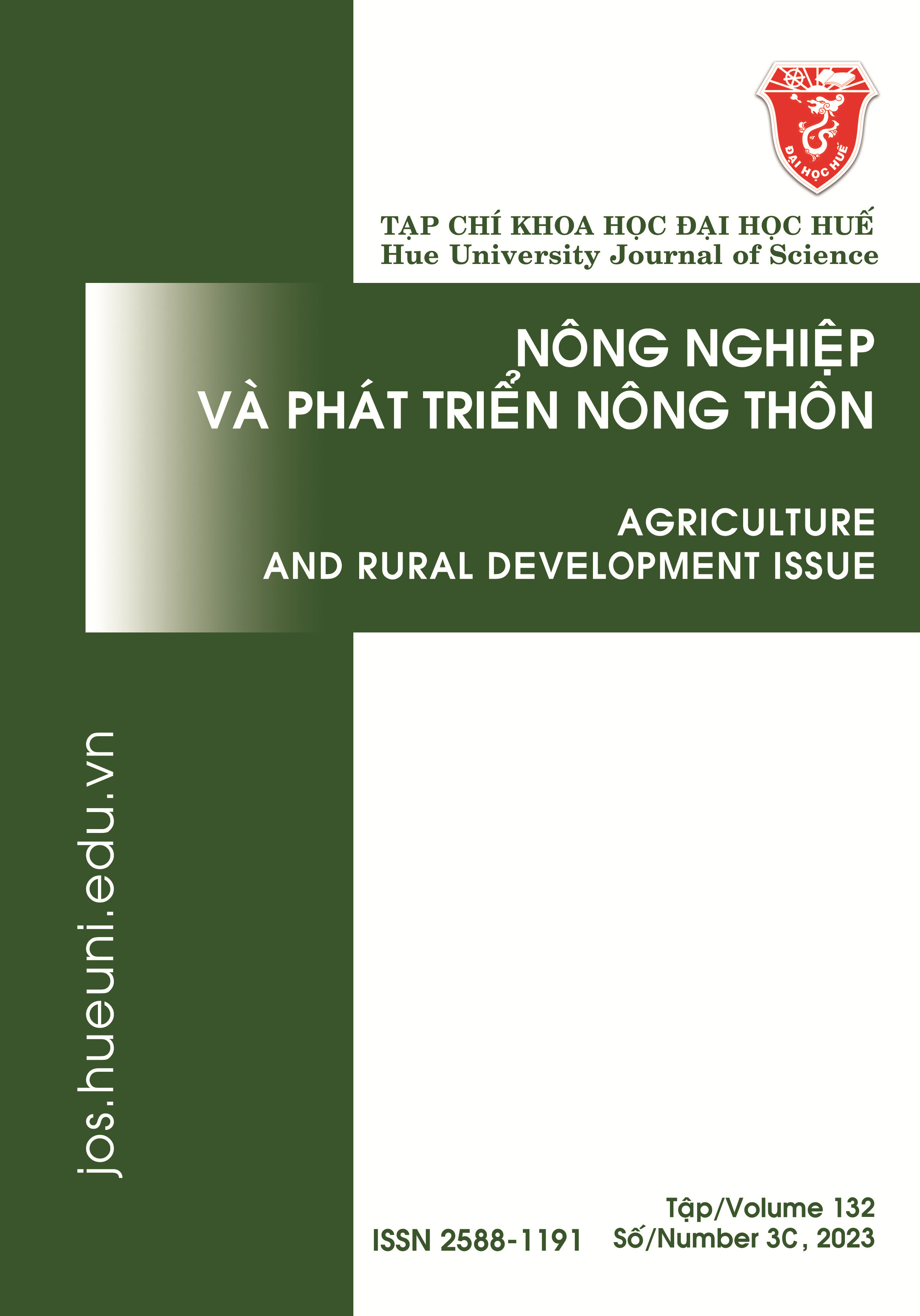Tóm tắt
Evaluation of land use and land cover change (LULC) is necessary for densely vegetated areas like Huong Hoa district, Quang Tri province. It is a basis for sustainable development strategies. Therefore, the study aims to evaluate the LULC change in the 10-year period of 2013–2023 by using Landsat 8 satellite image data with the Maximum Likelihood Classification method and to predict future LULC changes. The LULC maps for 2013, 2018, and 2023 are accurate, with Kappa coefficients of 0.82–0.85. In the period of 2013–2023, the dense vegetation area tended to decrease by 1.4%. The decrease was mainly due to the transition to sparse vegetation cover. Bare land increased by 0.5%, and the built-up area decreased by 0.6%. Meanwhile, the water bodies changed slightly. The prediction of LULC change with the CA-ANN model in the QGIS MOLUSCE plugin is based on the history of LULC change and two spatial variables: DEM and distance to the road. The accuracy of the CA-ANN model is satisfactory, with an overall accuracy of 86% and a Kappa coefficient of 0.76. In the simulated LULC of 2033, dense vegetation is predicted to keep a higher decrease (2%) in the area compared with the LULC of 2023. Sparse vegetation steadily increased by 1.3% over the subsequent 10 years. Similarly, the built-up area, water boddies, and bare land extended slightly by 0.5, 0.1, and 0.1%, respectively. The CA-ANN model in the QGIS MOLUSCE plugin is suitable for the simulated LULC changes for the studied area.
Tài liệu tham khảo
- Sudhakar, S. & Kameshwara, R. (2010), Land Use and Land Cover Analysis, in Roy, P. S., Dwivedi, R. S. and Vijayan (Ed.), D., Remote Sensing Applications, NRSC.
- Government of Canada, Land Cover/Biomass Mapping. https://www.nrcan.gc.ca/maps-tools-and-publications/satellite-imagery-and-air-photos/tutorial-fundamentals-remote-sensing/educational-resources-applications/land-cover-biomass-mapping/land-cover-land-use/9373, Accessed 12 May 2023.
- EPA (2012), Impacts of changes in land use and land cover on U.S, Air quality: Development and application of an integrated climate-vegetation-chemistry modeling system. http://cfpub.epa.gov/si/si_public_comments.cfm.
- Shahrin, N. N., Asmat, A., Hazali, N. A., Sahak, N. (2019), Land use and land cover (LULC) modification on the climate and air quality variations, IOP Conf. Ser.: Earth Environ. Sci., 373 012009. https://doi.org/10.1088/1755-1315/373/1/012009.
- Rawat, J. S. & Kumar, M. (2015), Monitoring land use/cover change using remote sensing and GIS techniques: A case study of Hawalbagh block, district Almora, Uttarakhand, India The Egyptian Journal of Remote Sensing and Space Science, 18(1), 77–84. https://doi.org/10.1016/j.ejrs.2015.02.002.
- Alshari, E. A. & Gawali, B. W. (2021), Development of classification system for LULC using remote sensing and GIS. Global Transitions Proceedings, 2(1), 8–17. https://doi.org/10.1016/j.gltp.2021.01.002.
- Samal, D. R. & Gedam, S. S. (2015), Optimal ground control points for geometric correction using genetic algorithm with global accuracy, Eur. J. Remote Sens., 48, 85–99.
- Wubie, M. A., Assen, M., Nicolau, M. D. (2016), Patterns, causes and consequences of land use / cover dynamics in the Gumara watershed of lake Tana basin, Northwestern Ethiopia, Environ. Syst. Res., 5, 1–12.
- Mishra, V. N., Prasad, R., Kumar, P., Gupta, D. K., Dikshit, P. K. S., Dwivedi, S., Singh, R. S., Srivastava, V. (2015), Supervised Algorithms for Classification of Remotely Sensed Satellite Image using Open Source Support, Conference: National Conference on Open Source GIS: Opportunities and Challenges, Department of Civil Engineering, IIT (BHU), Varanasi.
- Norovsuren, B., Tseveen, B., Batomunkuev, V., Renchin, T., Natsagdorj, E., Yangiv, A., Mart, Z. (2019), Land cover classification using maximum likelihood method (2000 and 2019) at Khandgait valley in Mongolia, IOP Conf. Ser.: Earth Environ. Sci., 381, 012054. https://doi.org/10.1088/1755-1315/381/1/012054.
- Seyam, Md. M. H., Haque, Md. R., Rahman, Md. M. (2023), Identifying the land use land cover (LULC) changes using remote sensing and GIS approach: A case study at Bhaluka in Mymensingh, Bangladesh, Case Studies in Chemical and Environmental Engineering, 7, 100293.
- Kamaraj, M. & Rangarajan, S. (2022), Predicting the Future Land Use and Land Cover Changes for Bhavani Basin, Tamil Nadu, India Using QGIS MOLUSCE Plugin, Environmental Science and Pollution Research, 29, 86337–86348.
- People's Committee of Huong Hoa district (2022), Report on implementation of Socio-economic Development Tasks in 2022 and Socio-economic Development Plan in 2023, Huong Hoa district.
- ArcGIS Desktop 9.3 Help (2011), How Maximum Likelihood Classification works. https://webhelp.esri.com/arcgisdesktop/9.3/index.cfm?TopicName=How%20Maximum%20Likelihood%20Classification%20works. (Accessed 12 May 2023).
- Richards, J. A. (1986), Remote Sensing Digital Image Analysis, 173–189. https://doi.org/10.1007/978-3-662-02462-1_8.
- Liang, S., Cheng, J., Zhang, J. (2020), Maximum likelihood classification of soil remote sensing image based on deep learning, Earth Sci. Res. J., 24(3), 357–365. https://doi.org/10.15446/esrj.v24n3.89750.
- ESRI (2021), Compute Confusion Matrix. https://desktop.arcgis.com/en/arcmap/latest/tools/spatial-analyst-toolbox/compute-confusion-matrix.htm. (Accessed 20/5/2023).
- Leta, M. K., Demissie, T. A., Tränckner, J. (2021), Modeling and Prediction of Land Use Land Cover Change Dynamics Based on Land Change Modeler (LCM) in Nashe Watershed, Upper Blue Nile Basin, Ethiopia, Sustainability, 13(7), 3740. https://doi.org/10.3390/su13073740.
- Xiong, N., Yu, R., Yan, F., Wang, J. & Feng, Z. (2022), Land use and Land cover changes and prediction based on Multi-Scenario Simulation: A case study of Qishan County, China. Remote Sensing, 14(16), 4041.
- Muhammad, R., Zhang, W., Abbas, Z., Guo, F., Gwiazdzinski, L. (2022), Spatiotemporal Change Analysis and Prediction of Future Land Use and Land Cover Changes Using QGIS MOLUSCE Plugin and Remote Sensing Big Data: A Case Study of Linyi, China, Land, 11(3), 419. https://doi.org/10.3390/land11030419.
- Abbas, Z. & Jaber, H. S. (2020), Accuracy assessment of supervised classification methods for extraction land use maps using remote sensing and GIS techniques, IOP Conf. Ser.: Mater. Sci. Eng., 745, 012166. https://doi.org/10.1088/1757-899X/745/1/012166.
- People's Committee of Huong Hoa district (2022), Report on Current Land Use Status in Huong Hoa district, Quang Tri province in 2022.
- Lukas, P., Melesse, A. M., Kenea, T. T. (2023), Prediction of Future Land Use/Land Cover Changes Using a Coupled CA-ANN Model in the Upper Omo–Gibe River Basin, Ethiopia, Remote Sens., 15(4), 1148. https://doi.org/10.3390/rs15041148.
